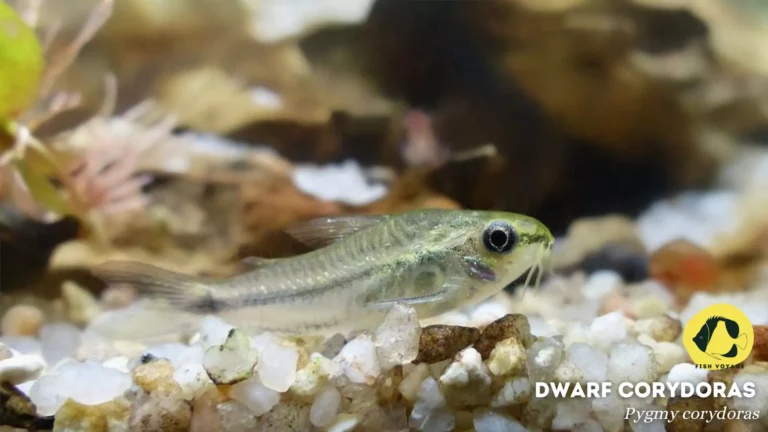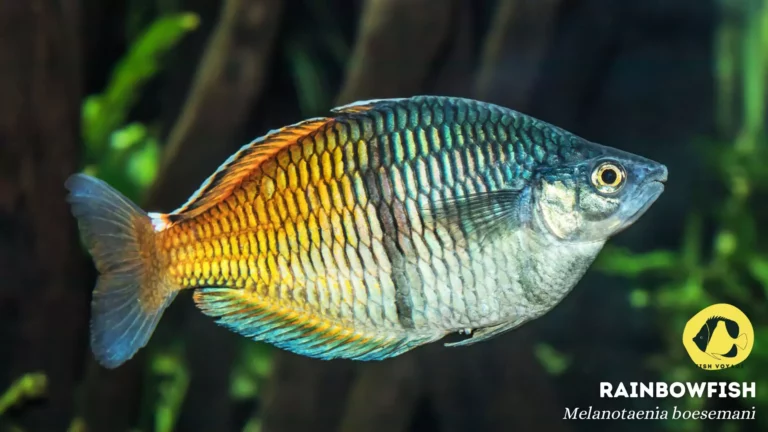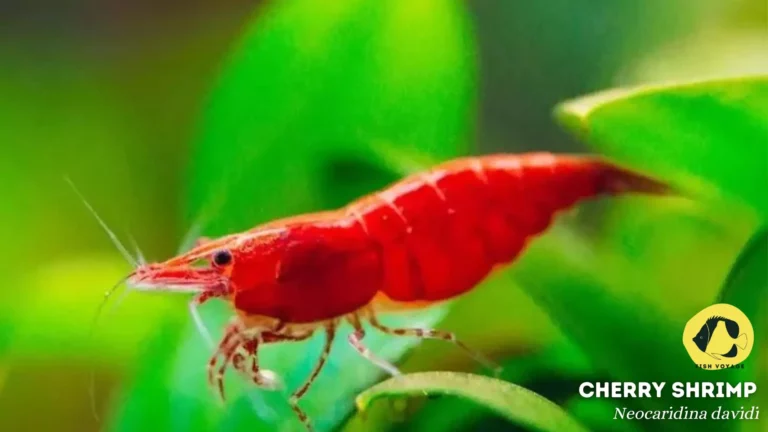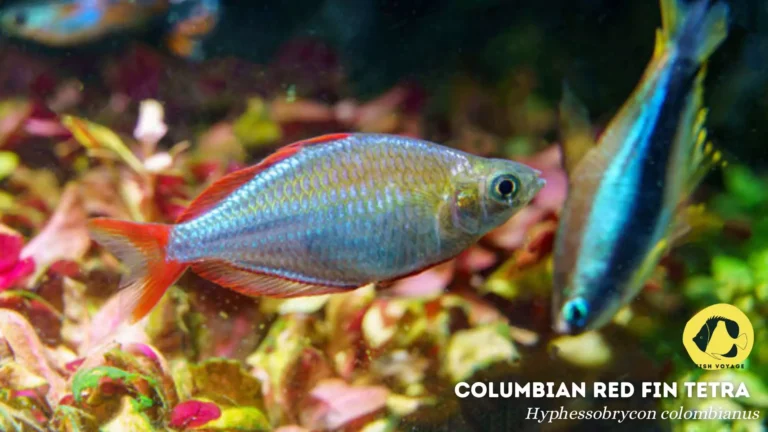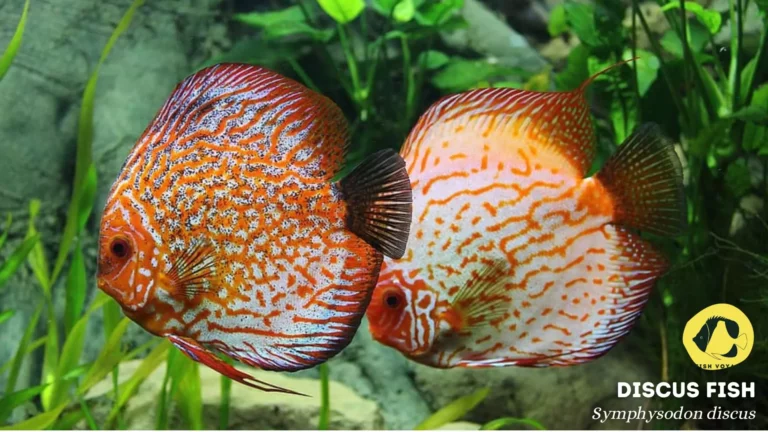10 Unusual Community Fishes for Your Tank
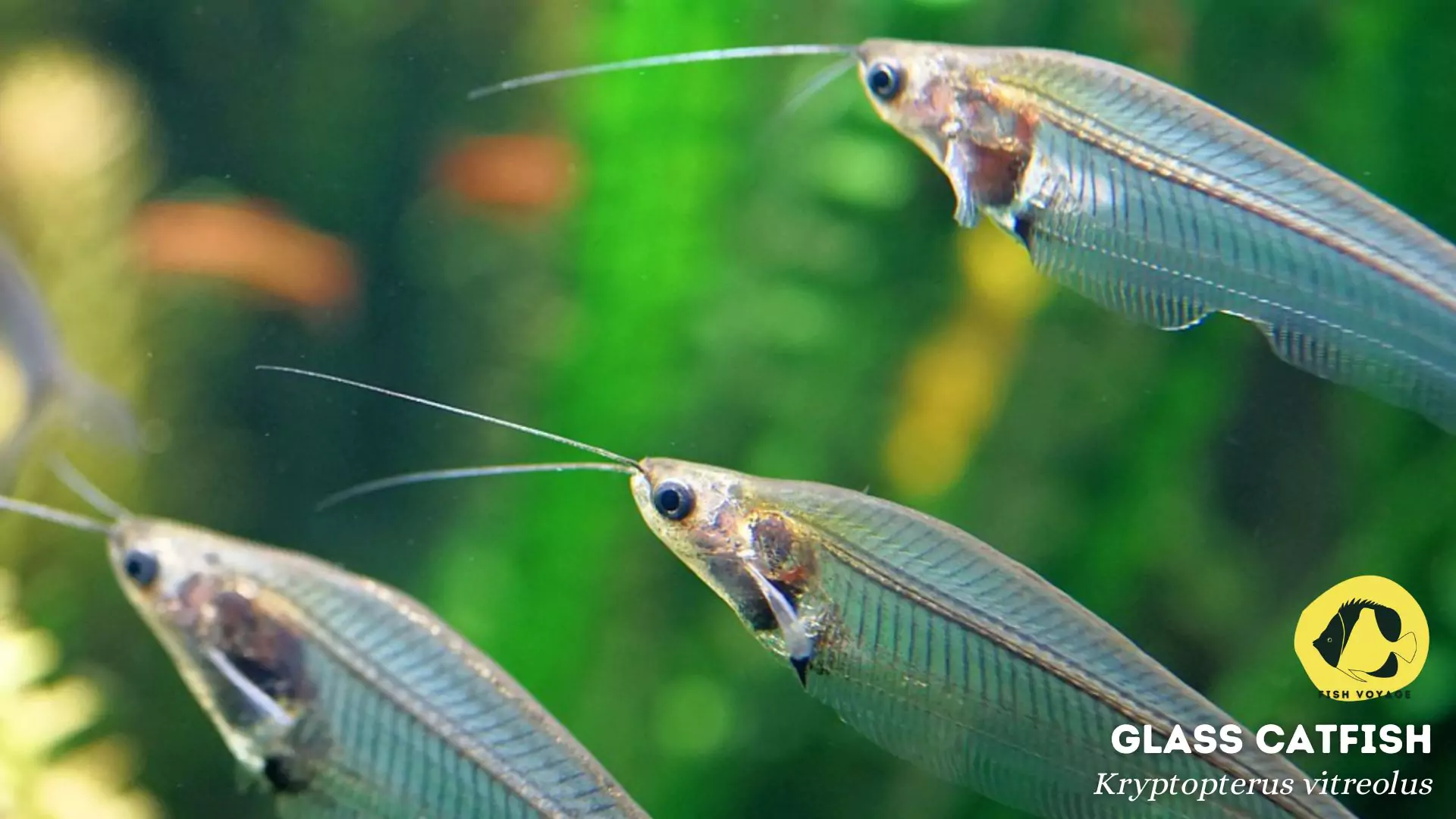
In the enchanting world of aquariums, the allure of a community fish tank lies in the captivating tapestry woven by diverse and unique species. Imagine an underwater symphony where each fish contributes its distinct melody to the harmonious ensemble. The appeal of such aquariums transcends the visual spectacle, offering enthusiasts a glimpse into the fascinating interactions of different aquatic inhabitants.
Beyond the aesthetic charm, the pivotal factor defining the success of a community tank is the delicate dance of compatibility among its residents. The careful selection of fish species, considering their temperaments, sizes, and habitat preferences, ensures a thriving and peaceful aquatic community. Embark on this aquatic journey as we explore the realm of unusual community fish, discovering the art of fostering a living masterpiece beneath the water’s surface.
Benefits of Community Fish Tanks
Diving into the realm of community fish tanks unveils a host of advantages that extend beyond the glass confines of an aquarium. First and foremost, fostering a community of fish promotes a harmonious environment marked by reduced aggression. Unlike solitary setups, where territorial disputes may arise, a community tank encourages a collaborative spirit among its finned residents.
The aesthetic appeal of a diverse community cannot be overstated. With an array of colors, sizes, and behaviors, each fish contributes to the visual symphony of the underwater landscape. The dynamic interplay of species enhances the overall beauty of the tank, creating an ever-changing tableau that captivates both seasoned enthusiasts and newcomers alike.
Moreover, a community tank evolves into a microcosm of nature’s intricate balance, fostering a more dynamic ecosystem. The symbiotic relationships and interconnected behaviors of various fish species contribute to the overall health and vitality of the aquatic environment. This natural balance reduces the likelihood of common issues such as overpopulation or nutrient imbalances, creating a self-sustaining aquatic microcosm.
Beyond the aesthetics and ecosystem benefits, a community tank serves as an educational canvas. Observing the diverse behaviors, social structures, and hierarchies of different fish species provides a unique opportunity for enthusiasts to delve into the intricacies of aquatic life. It not only enriches one’s understanding of the natural world but also instills a sense of responsibility for the welfare of these captivating creatures.
In essence, a community fish tank transcends being a mere decorative element; it becomes a living, breathing tapestry that showcases the beauty of unity in diversity. Whether you’re a seasoned hobbyist or a curious beginner, the benefits of a community tank extend far beyond its glass confines, inviting you to witness and appreciate the wonders of a thriving aquatic society.
Selecting Unusual Community Fish
Embarking on the journey of selecting unusual community fish requires a thoughtful approach, balancing uniqueness with compatibility to ensure a flourishing underwater community. When curating your aquatic ensemble, consider the following tips to create a harmonious tapestry of distinct species within your tank.
Size Matters
Ensure compatibility in size among the chosen fish. A mix of species with similar size requirements helps prevent issues related to aggression or predation, fostering a more balanced environment.
Temperament Harmony
Take into account the temperament of each fish species. Some may be more assertive, while others prefer a peaceful coexistence. Striking a balance ensures that no single species dominates the tank, promoting a tranquil atmosphere.
Water Parameter Alignment
Different fish species have specific water parameter preferences, including temperature, pH, and hardness. Research the ideal conditions for each species and create a tank environment that accommodates the collective needs, minimizing stress and promoting overall well-being.
Species Research
Delve into the individual requirements and behaviors of each species you intend to include. Understanding the social structures, feeding habits, and preferred hiding spots of your chosen fish enables you to tailor the tank environment to their specific needs.
Ecological Considerations
Mimic natural ecosystems by selecting fish that occupy different niches within the tank. This includes surface-dwelling, mid-level, and bottom-dwelling species. By diversifying the spatial usage, you create a more engaging and visually appealing underwater landscape.
Community Compatibility
Research the compatibility of your chosen fish species as a community. Some species thrive in the company of others, while certain combinations may lead to territorial disputes. Strive for a well-balanced mix to promote social interactions without undue stress.
In curating your collection of unusual community fish, the key lies in meticulous planning and research. Each species contributes its uniqueness to the collective aesthetic, forming a captivating aquatic community. By prioritizing compatibility based on size, temperament, and ecological considerations, you embark on a journey to create a living masterpiece beneath the water’s surface—one where each finned resident not only stands out for its uniqueness but also harmonizes with the broader community for a thriving and visually stunning aquatic environment.
Top 10 Unusual Community Fish Species
Dive into the captivating world of unusual community fish species, where each aquatic inhabitant adds a unique flair to your underwater haven. Below is a curated list of five distinctive species, each bringing its own charm to the community tank.
Dwarf Gourami (Trichogaster lalius)
- Description: Known for their dazzling colors and elaborate fin displays, Dwarf Gouramis are a visually stunning addition to any aquarium. Their compact size makes them suitable for community setups.
- Natural Habitat: Originating from the slow-moving waters of Southeast Asia, particularly in rice fields and ponds, Dwarf Gouramis thrive in warm, densely planted environments.
- Unique Behaviors: These labyrinth fish exhibit a labyrinth organ, allowing them to breathe atmospheric air. Male Dwarf Gouramis are renowned for their intricate courtship rituals, adding a captivating social dynamic to the tank.
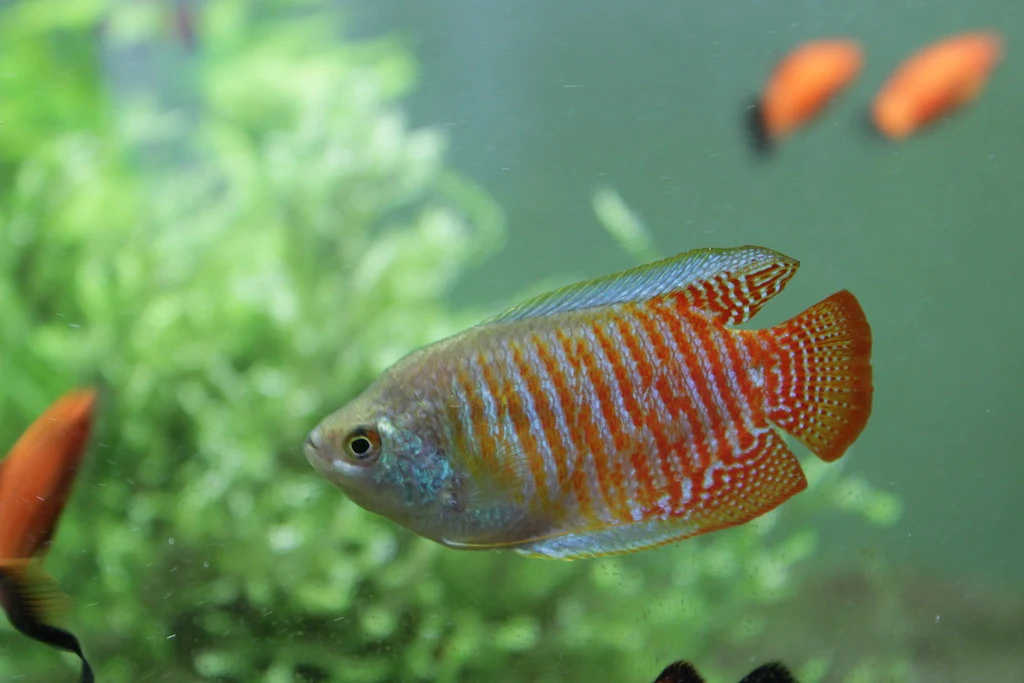
Corydoras Catfish (Corydoras spp.)
- Description: With their endearing appearance and bottom-dwelling habits, Corydoras Catfish are a delightful addition. They feature a distinctive armored appearance with barbels around their mouths.
- Natural Habitat: Originating from South America, Corydoras Catfish inhabit freshwater streams and rivers. They are well-adapted to scouring the substrate for food, contributing to tank cleanliness.
- Unique Behaviors: Corydoras are known for their playful antics and shoaling behavior. Keeping them in groups enhances their well-being, and their scavenging nature adds an efficient cleaning crew element to the tank.

Kuhli Loach (Pangio kuhlii)
- Description: Recognizable by their eel-like bodies and distinctive patterns, Kuhli Loaches are fascinating, nocturnal additions to a community tank. They are slender with a range of colors and patterns.
- Natural Habitat: Native to Southeast Asia, Kuhli Loaches thrive in slow-moving, heavily vegetated waters like streams and ponds. Their secretive nature makes them excellent tank inhabitants.
- Unique Behaviors: Kuhli Loaches are known for their burrowing tendencies and love for hiding in substrate or decorations. Observing their nocturnal exploration adds a mysterious allure to the tank.
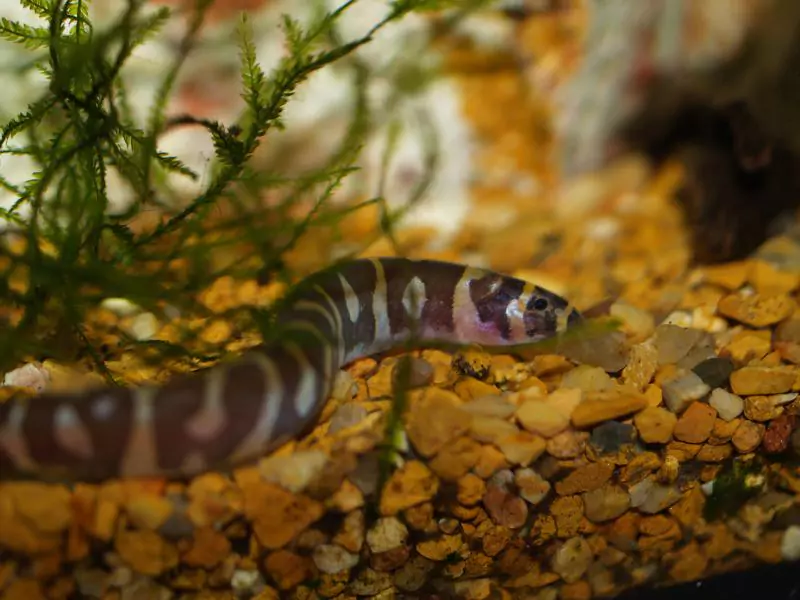
Pearl Gourami (Trichopodus leerii)
- Description: Renowned for their elegant appearance and tranquil demeanor, Pearl Gouramis boast iridescent scales that resemble pearls. They have a distinctive dorsal fin and are relatively peaceful.
- Natural Habitat: Native to Southeast Asia, Pearl Gouramis inhabit slow-moving waters, such as ponds and lakes. They prefer densely planted areas and open spaces for swimming.
- Unique Behaviors: Male Pearl Gouramis exhibit a unique courtship behavior where they build bubble nests at the water’s surface. This species adds grace and serenity to the community tank.
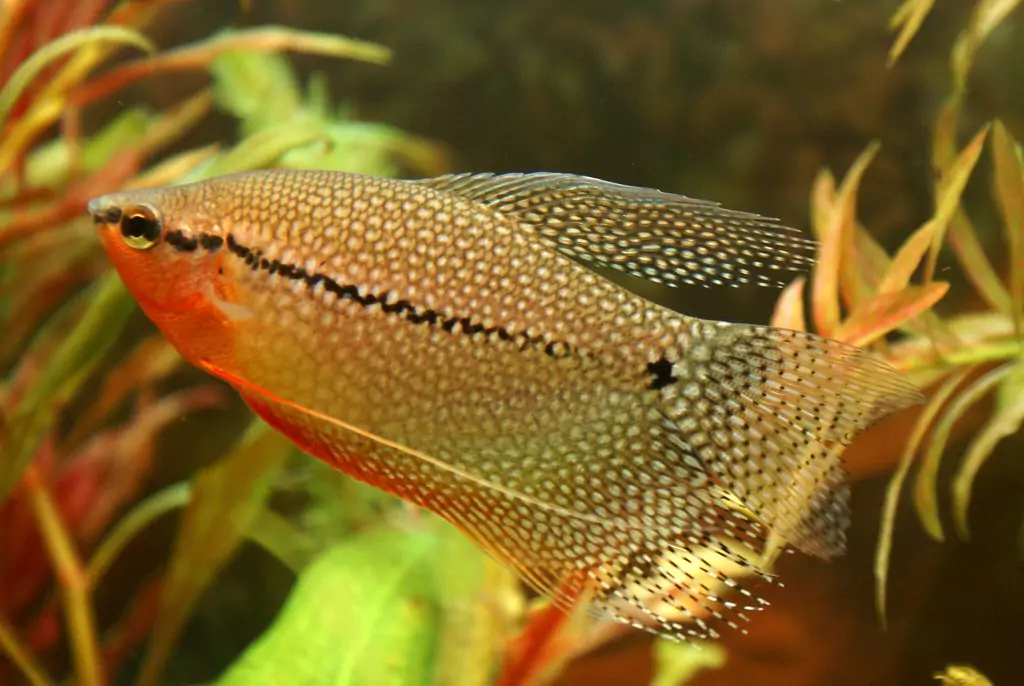
Harlequin Rasbora (Trigonostigma heteromorpha)
- Description: Harlequin Rasboras are vibrant, schooling fish with striking coloration, featuring orange-red bodies and distinctive black triangular patches. They add a lively and dynamic element to the tank.
- Natural Habitat: Originating from Southeast Asia, particularly in the clear, slow-moving waters of Malaysia, Thailand, and Sumatra, Harlequin Rasboras thrive in well-planted aquariums.
- Unique Behaviors: Harlequin Rasboras are social and thrive in groups. Their schooling behavior creates a visually appealing spectacle, and they are known for their peaceful coexistence with other community fish.

Celestial Pearl Danio (Danio margaritatus)
- Description: Also known as the Galaxy Rasbora, these small fish boast vibrant colors and distinctive pearl-like patterns. Their small size and peaceful nature make them suitable for community tanks.
- Natural Habitat: Native to Southeast Asia, specifically Myanmar, Celestial Pearl Danios inhabit slow-moving waters, particularly in shallow ponds and streams surrounded by dense vegetation.
- Unique Behaviors: Celestial Pearl Danios are known for their active swimming patterns and striking displays of color, especially during feeding and breeding.
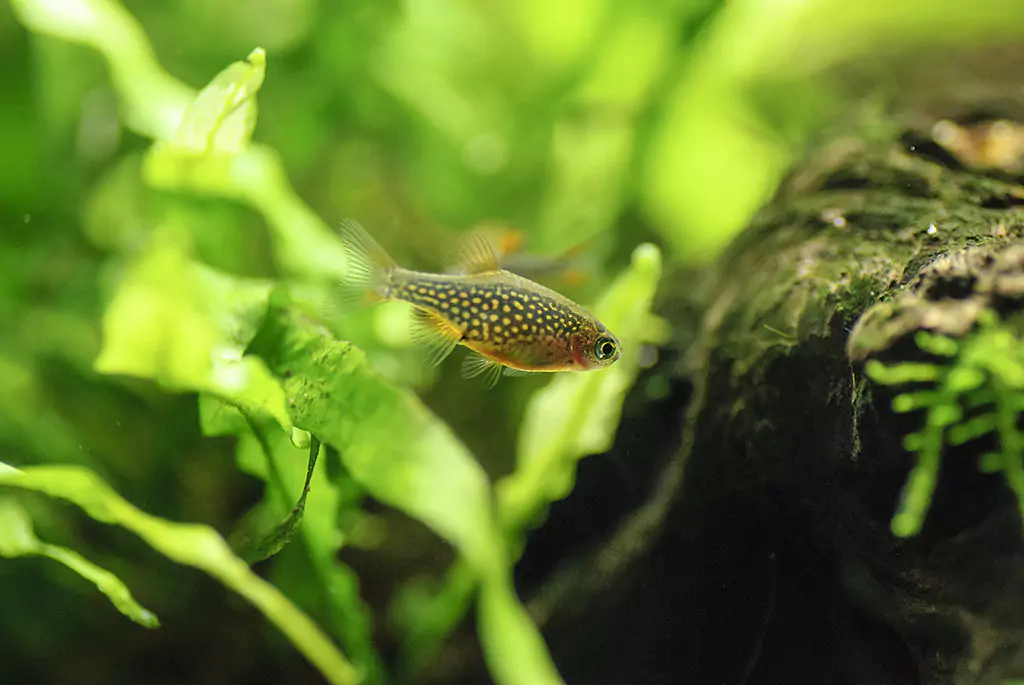
Honey Gourami (Trichogaster chuna)
- Description: With a golden-yellow hue and a peaceful demeanor, Honey Gouramis are a charming addition to community tanks. They have a labyrinth organ, allowing them to breathe air from the surface.
- Natural Habitat: Originating from India and Bangladesh, Honey Gouramis inhabit slow-moving waters, including rice paddies and ponds with abundant vegetation.
- Unique Behaviors: Male Honey Gouramis exhibit interesting courtship behaviors, creating bubble nests at the water’s surface. They are generally peaceful but may establish territories during breeding.
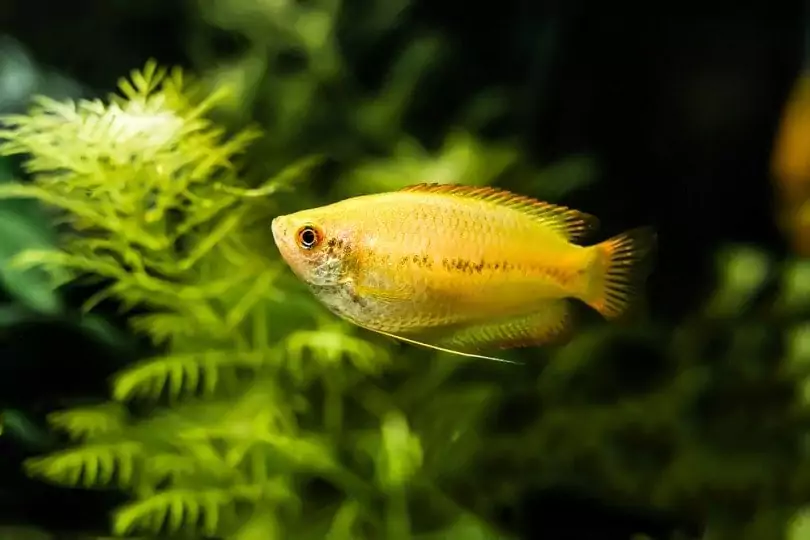
Threadfin Rainbowfish (Iriatherina werneri)
- Description: Recognizable by their elongated and delicate fins, Threadfin Rainbowfish are both visually striking and peaceful. Their slender bodies and iridescent colors add a graceful touch to community tanks.
- Natural Habitat: Native to northern Australia and New Guinea, these rainbowfish inhabit slow-moving rivers, streams, and swamps with ample aquatic plants.
- Unique Behaviors: Threadfin Rainbowfish exhibit schooling behavior and are known for their courtship displays, with males showcasing vibrant colors during breeding.

Killifish (Aphyosemion spp.)
- Description: Killifish are a diverse group known for their vibrant colors and unique patterns. They come in various species, each with its own distinctive appearance, making them an intriguing addition to community tanks.
- Natural Habitat: Killifish are found in a range of habitats, including streams, rivers, and seasonal pools, across Africa, Asia, and the Americas.
- Unique Behaviors: Some Killifish species are known for their short lifespan, making them ideal for enthusiasts interested in breeding and observing the different stages of their life cycle.

Glass Catfish (Kryptopterus vitreolus)
- Description: Transparent and ethereal, Glass Catfish are captivating due to their see-through bodies. Their unique appearance adds a touch of intrigue to community tanks.
- Natural Habitat: Native to Southeast Asia, Glass Catfish inhabit slow-moving rivers and streams with clear water. They prefer environments with hiding spots and subdued lighting.
- Unique Behaviors: Glass Catfish are known for their schooling behavior, and their transparent bodies allow for a fascinating view of their internal organs, creating a unique spectacle in the aquarium.
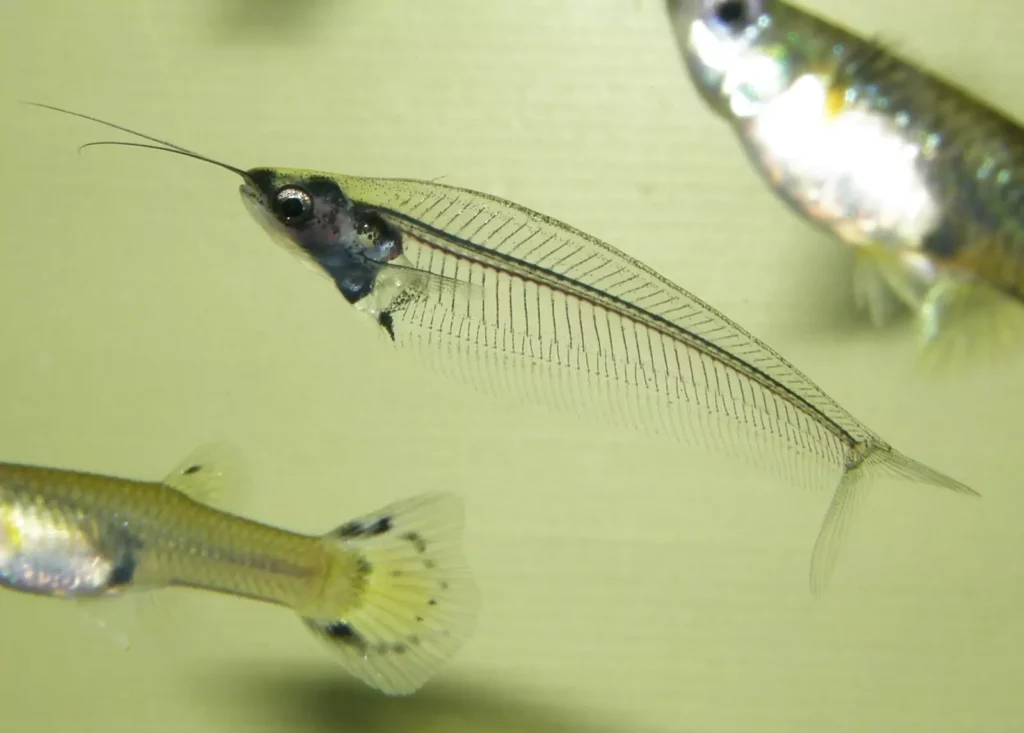
These top ten unusual community fish species not only bring aesthetic beauty to your aquarium but also contribute to a dynamic and harmonious underwater environment. As you consider introducing these fascinating species, remember to provide a well-balanced and species-appropriate environment for each, ensuring the optimal health and vitality of your aquatic community.
Setting Up Your Community Tank
Establishing an optimal environment for your community tank is pivotal to the well-being and harmony of its inhabitants. Here’s a comprehensive guide on setting up your aquarium, ensuring a habitat that fosters the health and happiness of a diverse range of fish.
Ideal Tank Size
When selecting a tank, consider the size based on the species you intend to keep. A general guideline is to allow at least one gallon of water per inch of fish. Larger tanks offer more stability in terms of water parameters and provide ample swimming space, reducing stress among your aquatic community.
Efficient Filtration
Invest in a quality filtration system to maintain water clarity and quality. Adequate filtration helps remove waste and toxins, ensuring a clean and healthy environment for your fish. Canister filters or sponge filters are popular choices for community tanks, offering efficient mechanical and biological filtration.
Thoughtful Decorations
Introduce a variety of decorations to cater to the diverse needs of your fish. Rocks, driftwood, and live plants not only enhance the aesthetics but also create hiding spots and territories. Ensure decorations are arranged to provide open spaces for active swimmers and secluded areas for more timid species.
Hiding Spots and Territories
Consider the natural behaviors of your chosen fish and incorporate hiding spots and territorial features. Use plants, caves, and ornaments strategically to allow each species to establish its space. This reduces stress and promotes a more natural social structure within the community.
Water Parameters
Research and maintain the specific water parameters required by your chosen fish species. Factors such as pH, hardness, and alkalinity vary among species. Consistency in water conditions is crucial for the overall well-being of your community, minimizing stress and potential health issues.
Temperature Control
Keep the water temperature within the recommended range for your fish. Use a reliable heater to maintain stability, as fluctuations can stress the fish. Most tropical community fish thrive in temperatures ranging from 75°F to 80°F (24°C to 27°C). Regular monitoring ensures a comfortable and stable environment.
Lighting Considerations
Tailor your lighting setup to mimic the natural day-night cycle. While some fish may appreciate brighter lighting, others, especially those from dimly lit habitats, might prefer subdued lighting. Live plants may require specific light spectrums for optimal growth.
Regular Monitoring and Maintenance
Establish a routine for water testing and changes. Regular monitoring of water parameters, coupled with routine maintenance tasks like partial water changes, helps sustain a healthy and balanced ecosystem. Vacuum the substrate to remove debris and uneaten food, preventing the buildup of harmful substances.
By thoughtfully addressing tank size, filtration, decorations, hiding spots, and water parameters, you create an environment that caters to the diverse needs of your community fish. Striking this balance ensures not only the physical well-being but also the mental and social health of your aquatic residents. As you embark on this aquatic venture, envision your tank as a living masterpiece, where each species contributes to the vibrant symphony of underwater life.
Tips for Maintaining a Healthy Community Tank
Ensuring the long-term health and vitality of your community tank requires a proactive and attentive approach to maintenance. Here’s a comprehensive guide on essential tips to maintain a flourishing aquatic ecosystem that delights both fish and enthusiasts alike.
Regular Water Changes
Conduct routine water changes to eliminate accumulated toxins, uneaten food, and waste. Aim for weekly or bi-weekly changes, replacing about 15-20% of the water. This simple yet effective practice helps maintain optimal water quality, promoting the well-being of your fish.
Water Testing
Regularly test the water parameters to monitor key indicators such as pH, ammonia, nitrites, and nitrates. Use reliable testing kits to ensure accuracy. Understanding your water chemistry allows you to make informed adjustments and prevent potential issues before they impact the health of your community.
Monitoring Fish Behavior
Pay close attention to the behavior of your fish. Changes in swimming patterns, lethargy, or unusual hiding can be indicative of stress, illness, or aggression. Observing their interactions provides valuable insights into the dynamics of the community, allowing you to address any concerns promptly.
Prompt Illness Intervention
Act promptly if you notice any signs of illness. Quarantine affected fish to prevent the spread of diseases, and seek advice from a knowledgeable source or veterinarian. Timely intervention is crucial in mitigating the impact of diseases and safeguarding the overall health of your community.
Balanced Feeding
Adopt a balanced and varied feeding regimen. Different species have varying dietary needs, and providing a mix of high-quality flake, pellet, frozen, and live foods ensures a well-rounded nutrition profile. Avoid overfeeding, as excess food can lead to water quality issues and health problems for the fish.
Avoid Overstocking
Resist the temptation to overcrowd your tank. Overstocking leads to increased waste production, heightened competition for resources, and elevated stress levels among fish. Research the adult size of each species and plan your community accordingly to maintain a harmonious balance.
Clean Substrate and Decorations
Regularly clean the substrate and decorations to remove debris and detritus. This not only enhances the aesthetic appeal of the tank but also prevents the accumulation of organic matter that can contribute to water quality issues. Use a gentle substrate vacuum to efficiently clean the substrate during water changes.
Quarantine New Additions
Quarantine new fish before introducing them to the main tank. This precautionary measure helps prevent the spread of diseases and allows you to observe their health and behavior in isolation. Quarantine periods can range from a few days to a few weeks, depending on the species.
By integrating these tips into your routine, you cultivate a proactive approach to maintaining a healthy and thriving community tank. Remember, each tank is a unique ecosystem, and attentive care ensures that it remains a vibrant and harmonious aquatic haven for your diverse finned companions.
Troubleshooting Common Issues
Maintaining a community tank can be a rewarding endeavor, but it’s not without its challenges. Understanding and troubleshooting common issues is essential to fostering a thriving and harmonious aquatic environment. Below is a detailed guide on addressing potential challenges that may arise in your community tank.
Aggression Among Tank Inhabitants
- Issue: Aggressive behavior, often territorial disputes, can disrupt the peace in your community tank.
- Solution: Introduce more hiding spots and visual barriers to break lines of sight. Rearrange decorations occasionally to redefine territories. If aggression persists, consider removing the aggressor temporarily or permanently.
Disease Outbreaks
- Issue: Diseases like ich or fin rot can spread quickly, affecting the entire community.
- Solution: Quarantine affected fish promptly to prevent the spread of illness. Treat the isolated fish with appropriate medications. Ensure that your main tank’s water parameters are optimal to support the recovery of affected fish.
Compatibility Problems
- Issue: Some fish may not coexist peacefully, leading to constant stress or skirmishes.
- Solution: Research and understand the compatibility of fish species before introducing them. If issues arise, consider rehoming or isolating incompatible species. Pay attention to individual preferences for hiding spots.
Algae Overgrowth
- Issue: Excessive algae growth can affect water quality and the overall aesthetics of the tank.
- Solution: Regulate lighting duration and intensity. Introduce algae-eating species like snails or certain fish. Regularly clean the tank and perform water changes to reduce nutrient levels that promote algae growth.
Water Quality Fluctuations
- Issue: Inconsistent water parameters can stress fish and lead to health issues.
- Solution: Regularly test and monitor water parameters. Conduct routine water changes to maintain stability. Adjust filtration and aeration as needed. Address any sudden changes promptly to prevent stress.
Overfeeding
- Issue: Excess food can lead to water quality problems and obesity in fish.
- Solution: Establish a feeding schedule and stick to appropriate portion sizes. Remove uneaten food promptly. Consider incorporating fasting days to prevent overfeeding.
Breeding Overpopulation
- Issue: If certain species breed prolifically, it can lead to overpopulation.
- Solution: Separate breeding pairs or provide adequate hiding spots to protect fry. Consider introducing natural predators or rehoming excess juveniles. Adjust feeding to influence breeding behavior.
Poor Plant Growth
- Issue: Live plants may struggle to thrive, affecting the overall balance of the tank.
- Solution: Ensure adequate lighting and provide essential nutrients through liquid fertilizers or substrate additives. Trim and remove dead plant matter regularly. Choose plant species that suit your tank’s specific conditions.
Filtration Issues
- Issue: Inadequate filtration can result in poor water quality and stress.
- Solution: Choose a filtration system appropriate for your tank size. Clean or replace filter media regularly. Ensure proper water flow and circulation. Consider additional filtration if needed.
By identifying and proactively addressing these common challenges, you pave the way for a healthy and balanced community tank. Regular observation, thoughtful adjustments, and a commitment to the well-being of your aquatic inhabitants contribute to the long-term success of your community aquarium.
Conclusion
In concluding our exploration of the fascinating realm of unusual community fish, we’ve delved into the art of creating and maintaining a thriving aquatic haven. From the initial selection of unique species to the intricacies of tank setup, we’ve uncovered the keys to cultivating a harmonious underwater community. The benefits of reduced aggression, enhanced aesthetics, and a dynamic ecosystem have been illuminated, underscoring the importance of thoughtful planning and attentive care.
As you embark on your journey into the captivating world of community fish, remember the significance of compatibility, balanced feeding, and proactive troubleshooting. Whether you’re a seasoned enthusiast or a newcomer to the aquarium hobby, the allure of unusual community fish lies in their diversity, behaviors, and the living masterpiece they collectively create.
We invite you to share your experiences, insights, and questions in the comments below. Your stories contribute to the wealth of knowledge within our community, fostering a space for enthusiasts to learn and engage. Together, let’s continue to explore, learn, and celebrate the beauty of unusual community fish, creating vibrant aquatic tapestries that captivate and inspire. Thank you for joining us on this aquatic journey, and may your community tank be a source of joy and fascination for years to come.
Additional Resources
For further exploration and in-depth knowledge on the world of unusual community fish and effective tank management, consider delving into these valuable resources
- Aquatic Community: An interactive forum where aquarists from around the globe share experiences, advice, and insights. Engage with the community to seek guidance on specific fish species, troubleshooting common issues, and exchanging ideas.
- Aquarium Advice Forum: A popular US-based forum where aquarium enthusiasts share knowledge, experiences, and advice. Engage with the community to discuss unusual community fish and gain valuable insights.
- LiveAquaria: An extensive online resource for aquarium enthusiasts based in the US. LiveAquaria offers a wide selection of fish, invertebrates, and plants, along with informative articles on care and husbandry.
- The 101 Best Freshwater Nano Species by Mark Denaro: While not exclusively focused on community tanks, this book by Mark Denaro provides insights into smaller freshwater species suitable for community setups. Available for purchase on platforms like Amazon.
Dive into these resources to deepen your understanding of unusual community fish and refine your skills in aquarium management. Stay informed, connect with fellow enthusiasts, and continue to cultivate your passion for the captivating world of aquatic life.
Happy exploring!
Frequently Asked Questions (FAQs)
What are some unique and unusual community fish species for my aquarium?
Explore unique options like Dwarf Gouramis, Celestial Pearl Danios, and Kuhli Loaches. These species add vibrant colors and intriguing behaviors to your community tank.
How do I prevent aggression among different fish in my community tank?
To reduce aggression, provide ample hiding spots and territories. Rearrange decorations occasionally and research species compatibility before introducing them to the tank.
What water parameters are crucial for maintaining a healthy community tank?
Monitor and maintain optimal pH, ammonia, nitrite, and nitrate levels. Research the specific requirements of your fish species to ensure a stable and healthy aquatic environment.
How can I troubleshoot common issues like disease outbreaks in my community tank?
Promptly quarantine affected fish, treat with appropriate medications, and ensure optimal water conditions. Regular monitoring and a proactive approach to illness can prevent its spread.
What is the ideal tank size for a community setup, and how does it impact fish health?
Tank size matters; larger tanks provide stability and space for diverse species. Follow the guideline of one gallon of water per inch of fish and consider the adult size of your chosen species for a harmonious environment.

